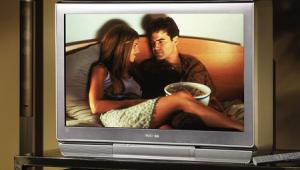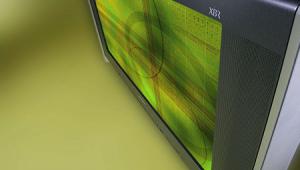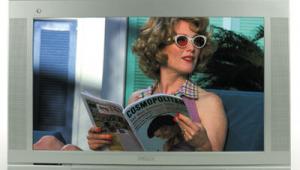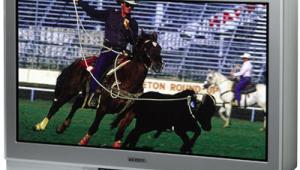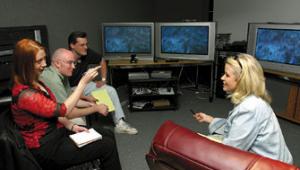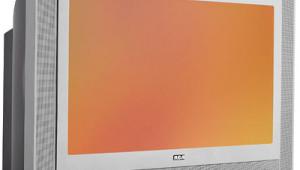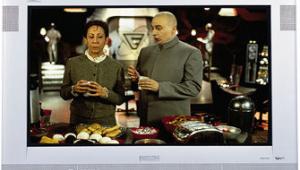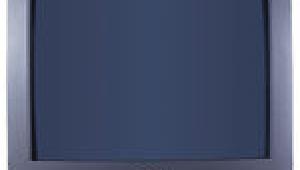Toshiba 34HDX82 direct-view HDTV Page 2
The Toshiba 34HDX82 presented a bad picture fresh out of the box. The image was so bright and blue that I worried it would damage the set, warping the invar shadow mask. Bright, white, almost luminescent lines set off the edges of faces, buildings, and other solid objects. Standalone white images glowed fluorescent and looked broken-up. Middle-dark areas exhibited significant video noise. I can remember few, if any, sets that looked as quite as bad as this right out of the box. However, I was able to quickly correct nearly all of these problems.
 Right away, I turned the Contrast control down to 50%. (It had arrived set at 100%.) Scan-velocity modulation, that pernicious function that over-accents bright areas, was also set too high. The user menu lets you turn it off, which I did with haste, after which the luminescent white lines disappeared. With some experimentation, I found that the Warm color-temperature setting gave the most realistic result. The 34HDX82 had arrived with this control set at Cool, which more accurately should be called Bright Blue. I turned off the Digital Noise Reduction, which softens the picture, and the Flesh Tone adjustment, which overemphasizes reddish hues. With these quick, minimal adjustments, 75% of the problems disappeared: in three minutes, the Toshiba looked pretty good.
Right away, I turned the Contrast control down to 50%. (It had arrived set at 100%.) Scan-velocity modulation, that pernicious function that over-accents bright areas, was also set too high. The user menu lets you turn it off, which I did with haste, after which the luminescent white lines disappeared. With some experimentation, I found that the Warm color-temperature setting gave the most realistic result. The 34HDX82 had arrived with this control set at Cool, which more accurately should be called Bright Blue. I turned off the Digital Noise Reduction, which softens the picture, and the Flesh Tone adjustment, which overemphasizes reddish hues. With these quick, minimal adjustments, 75% of the problems disappeared: in three minutes, the Toshiba looked pretty good.
Jamie Wilson of Overture Audio/Video performed a color-temperature calibration for me (see "Calibration" sidebar), improving the picture even more. Some sets don't benefit greatly from professional Imaging Science Foundation calibration, but the Toshiba was not one of them. It was delivered so badly calibrated that one might have second thoughts about buying it. The initial user-controlled adjustments get you 75% of the way there. But even after I'd adjusted the set's black level as best I could using the PLUGE pattern on the Video Essentials test DVD (chapter 17-2), the blacks were not as dark as they could be. Full calibration largely remedied that problem.
Performance
After full calibration, I watched My Big Fat Greek Wedding and parts of several other movies and found the Toshiba 34HDX82 quite pleasing—surprisingly good, after its poor out-of-the-box performance. Colors were rich and convincing. The red push that plagues most televisions—reds richer than they ought to be, even when everything else is set correctly—was less pronounced than with other sets. Resolution was superb; frequency-sweep test patterns were well defined down almost to the finest lines.
Most surprising was the quality of the scaler/line-doubler. For a built-in product, it was excellent. Images were clean and largely free of video noise. With 3:2 pulldown correction, stair-step artifacts were largely missing. Particularly difficult scenes on Video Essentials—pans of waving tree leaves, a flag flapping in the breeze, a pan across empty stadium seats—were all surprisingly error-free. I don't know how Toshiba did it, but I was impressed; in many DTVs, the line doubler is typically the weakest link.
As an HDTV display, the Toshiba was a fine performer. I watched local, over-the-air HDTV, as well as HD-Net and HBO HD on DirecTV. The pictures were pin-sharp and clear, and the color palette was broad and convincing—though, of course, this set, like every direct-view monitor, was unable to offer the full resolution of 1920x1080 high-definition. Like most DTVs, the 34HDX82 converts a 720p signal to a 1080i image.
Conclusions
The Toshiba 34HDX82 was a frog as it came out of the box. But with tweaking and adjustment, it turned into a prince: extraordinarily well-equipped and capable, a great performer, and easily recommended.
